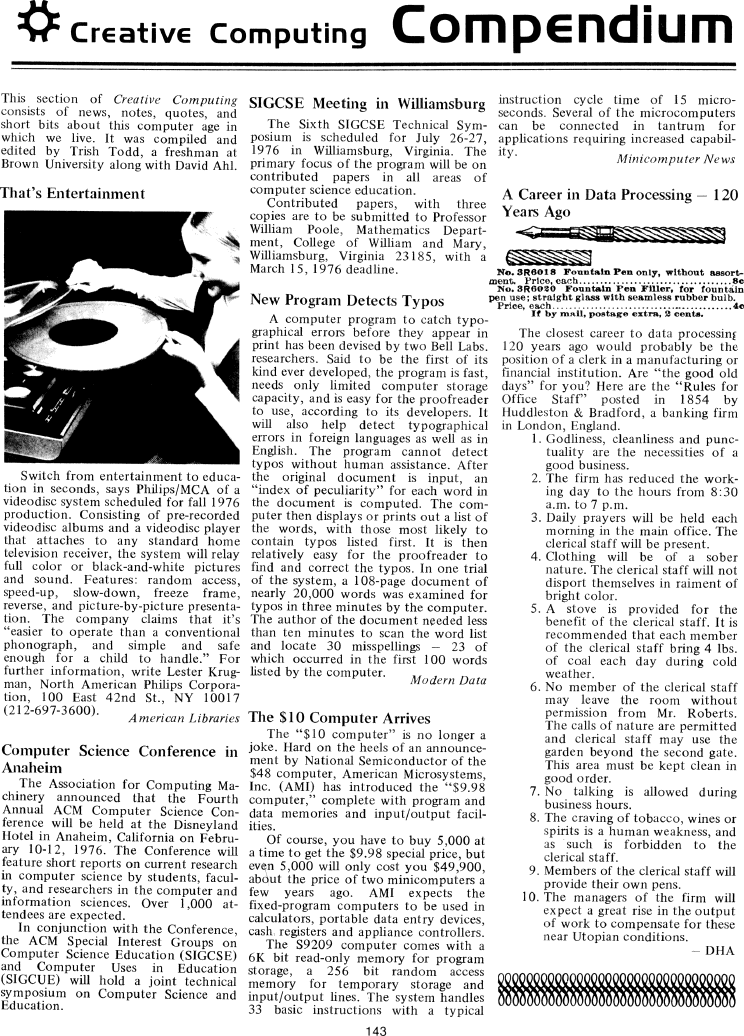The Best of Creative Computing Volume 1 (published 1976)
Creative Computing Compendium (First videodisc system, 1976 Association for Computing Machinery (ACM) conference, Sixth SIGCSE Technical Symposium, New Program Detects Typos, American Microsystems S9209 $10 computer, A Career in Data Processing 120 Years Ago)

Creative Computing Compendium
This section of Creative Computing
consists of news, notes, quotes, and
short bits about this computer age in
which we live. It was compiled and
edited by Trish Todd, a freshman at
Brown University along with David Ahl.
That's Entertainment
[Image]
Switch from entertainment to education
in seconds, says Philips/MCA of a
videodisc system scheduled for fall 1976
production. Consisting of pre-recorded
videodisc albums and a videodisc player
that attaches to any standard home
television receiver, the system will relay
full color or black-and-white pictures
and sound. Features: random access,
speed-up, slow-down, freeze frame,
reverse, and picture-by-picture presentation.
The company claims that it's
"easier to operate than a conventional
phonograph, and simple and safe
enough for a child to handle." For
further information, write Lester Krugman,
North American Philips Corporation,
100 East 42nd St., NY 10017
(212-697-3600).
American Libraries
***
Computer Science Conference in
Anaheim
The Association for Computing Machinery
announced that the Fourth
Annual ACM Computer Science Conference
will be held at the Disneyland
Hotel in Anaheim, California on February
10-12, 1976. The Conference will
feature short reports on current research
in computer science by students, faculty,
and researchers in the computer and
information sciences. Over 1,000 attendees
are expected.
In conjunction with the Conference,
the ACM Special Interest Groups on
Computer Science Education (SIGCSE)
and Computer Uses in Education
(SIGCUE) will hold a joint technical
symposium on Computer Science and
Education.
***
SIGCSE Meeting in Williamsburg
The Sixth SIGCSE Technical Symposium
is scheduled for July 26-27,
1976 in Williamsburg, Virginia. The
primary focus of the program will be on
contributed papers in all areas of
computer science education.
Contributed papers, with three
copies are to be submitted to Professor
William Poole, Mathematics Department,
College of William and Mary,
Williamsburg, Virginia 23185, with a
March 15, 1976 deadline.
***
New Program Detects Typos
A computer program to catch typographical
errors before they appear in
print has been devised by two Bell Labs.
researchers. Said to be the first of its
kind ever developed, the program is fast,
needs only limited computer storage
capacity, and is easy for the proofreader
to use, according to its developers. It
will also help detect typographical
errors in foreign languages as well as in
English. The program cannot detect
typos without human assistance. After
the original document is input, an
"index of peculiarity" for each word in
the document is computed. The computer
then displays or prints out a list of
the words, with those most likely to
contain typos listed first. It is then
relatively easy for the proofreader to
find and correct the typos. In one trial
of the system, a 108-page document of
nearly 20,000 words was examined for
typos in three minutes by the computer.
The author of the document needed less
than ten minutes to scan the word list
and locate 30 misspellings - 23 of
which occurred in the first 100 words
listed by the computer.
Modern Data
***
The $10 Computer Arrives
The "$l0 computer" is no longer a
joke. Hard on the heels of an announcement
by National Semiconductor of the
$48 computer, American Microsystems,
Inc. (AMI) has introduced the "$9.98
computer," complete with program and
data memories and input/output facilities.
Of course, you have to buy 5,000 at
a time to get the $9.98 special price, but
even 5,000 will only cost you $49,900,
about the price of two minicomputers a
few years ago. AMI expects the
fixed-program computers to be used in
calculators, portable data entry devices,
cash, registers and appliance controllers.
The S9209 computer comes with a
6K bit read-only memory for program
storage, a 256 bit random access
memory for temporary storage and
input/output lines. The system handles
33 basic instructions with a typical
143
instruction cycle time of 15 microseconds.
Several of the microcomputers
can be connected in tantrum for
applications requiring increased capability.
Minicomputer News
***
A Career in Data Processing - 120
Years Ago
[Image]
No.3R6018 Fountain Pen only, without assortment
Price, each..................................80
No.3R6020 Fountain Pen Filler, for fountain
pen use; straight glass with seamless rubber bulb.
Price, each..................................40
If by mail, postage extra, 2 cents.
The closest career to data processing
120 years ago would probably be the
position of a clerk in a manufacturing or
financial institution. Are "the good old
days" for you? Here are the "Rules for
Office Staff" posted in 1854 by
Huddleston & Bradford, a banking firm
in London, England.
l. Godliness, cleanliness and punctuality
are the necessities of a
good business.
2. The firm has reduced the working
day to the hours from 8:30
a.m. to 7 p.m.
3. Daily prayers will be held each
morning in the main office. The
clerical staff will be present.
4. Clothing will be of a sober
nature. The clerical staff will not
disport themselves in raiment of
bright color.
5. A stove is provided for the
benefit of the clerical staff. It is
recommended that each member
of the clerical staff bring 4 lbs.
of coal each day during cold
weather.
6. No member of the clerical staff
may leave the room without
permission from Mr. Roberts.
The calls of nature are permitted
and clerical staff may use the
garden beyond the second gate.
This area must be kept clean in
good order.
7. No talking is allowed during
business hours.
8. The craving of tobacco, wines or
spirits is a human weakness, and
as such is forbidden to the
clerical staff.
9. Members of the clerical staff will
provide their own pens.
10. The managers of the firm will
expect a great rise in the output
of work to compensate for these
near Utopian conditions.
- DHA
[Image]


